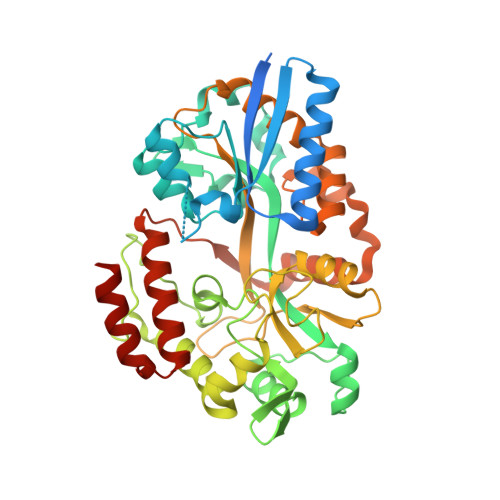Structural and Biochemical Basis for Mannan Utilization by Caldanaerobius polysaccharolyticus Strain ATCC BAA-17.
Chekan, J.R., Kwon, I.H., Agarwal, V., Dodd, D., Revindran, V., Mackie, R.I., Cann, I., Nair, S.K.(2014) J Biological Chem 289: 34965-34977
- PubMed: 25342756
- DOI: https://doi.org/10.1074/jbc.M114.579904
- Primary Citation of Related Structures:
4R9F, 4R9G - PubMed Abstract:
Hemicelluloses, the polysaccharide component of plant cell walls, represent one of the most abundant biopolymers in nature. The most common hemicellulosic constituents of softwoods, such as conifers and cycads, are mannans consisting of a 1,4-linked β-mannopyranosyl main chain with branch decorations. Efforts toward the utilization of hemicellulose for bioconversion into cellulosic biofuels have resulted in the identification of several families of glycoside hydrolases that can degrade mannan. However, effective biofermentation of manno-oligosaccharides is limited by a lack of appropriate uptake route in ethanologenic organisms. Here, we used transcriptome sequencing to gain insights into mannan degradation by the thermophilic anaerobic bacterium Caldanaerobius polysaccharolyticus. The most highly up-regulated genes during mannan fermentation occur in a cluster containing several genes encoding enzymes for efficient mannan hydrolysis as well as a solute-binding protein (CpMnBP1) that exhibits specificity for short mannose polymers but exhibited the flexibility to accommodate branched polysaccharide decorations. Co-crystal structures of CpMnBP1 in complex with mannobiose (1.4-Å resolution) and mannotriose (2.2-Å resolution) revealed the molecular rationale for chain length and oligosaccharide specificity. Calorimetric analysis of several active site variants confirmed the roles of residues critical to the function of CpMnBP1. This work represents the first biochemical characterization of a mannose-specific solute-binding protein and provides a framework for engineering mannan utilization capabilities for microbial fermentation.
- From the Departments of Biochemistry, Institute for Genomic Biology.
Organizational Affiliation:


















